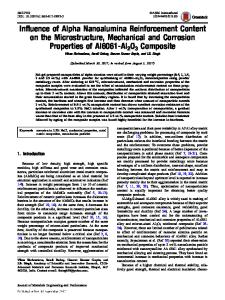Influence of SiC Content on Microstructure and Tribological Properties of Friction Stir-Processed SiC/AA5083 Surface Com
- PDF / 4,594,859 Bytes
- 12 Pages / 593.972 x 792 pts Page_size
- 12 Downloads / 277 Views
TION
ALUMINUM 5083 is a non-heat treatable alloy, widely used in shipbuilding, armor plate, marine, railroad cars, and storage tank applications because of its corrosion resistance, low density, and exceptional strength after welding.[1–6] Aluminum metal matrix composites (AMMCs) reinforced with various ceramic particles fabricated by liquid metallurgy,[7,8] and powder metallurgy[9,10] route shows poorer mechanical and tribological properties, due to the inhomogeneous microstructure, solidification defects, and interfacial reaction product. Therefore, incorporation of ceramic particles on the surface of aluminum alloys enhances both mechanical and tribological properties. Recently, the hard coatings were deposited on aluminum alloys using several surface modification techniques like physical vapor deposition,[11] anodizing,[12] ion-beam deposition,[13] plasma spraying,[14] micro-arc oxidation,[15]
VIKRAM KUMAR S. JAIN and S. MUTHUKUMARAN are with the Department of Metallurgical and Materials Engineering, National Institute of Technology Tiruchirappalli, Tiruchirappalli, Tamil Nadu 620 015, India. Contact e-mail: [email protected] Manuscript submitted August 9, 2018.
METALLURGICAL AND MATERIALS TRANSACTIONS A
and high energy laser melt injection[16] to improve surface properties. However, these coatings which are of a few microns in thickness, may break down quickly when the load is applied. Moreover, these techniques are expensive, time-consuming, have low interfacial bonding, and not eco-friendly owing to their long run time, costly consumables, detrimental phases in material, and toxic emissions. To overcome the problems stated above, friction stir processing (FSP) evolved as a solid-state processing technique for the fabrication of aluminum-based surface composites. Surface composites were prepared by introducing reinforcement in an array of holes/grooves, machined on the surface of the substrate. Then, a non-consumable rotating tool with a specially designed pin and shoulder are plunged into the substrate and traverses in the hole or groove direction. The frictional heating between tool and substrate softens the material, and the combined effect of tool rotation speed and traverse speed induces plastic flow and dynamic mixing of reinforcement which results in the uniform dispersion of particles. Mishra et al.[17] developed the friction stir processing (FSP) technique to modify microstructural features and produce the ultrafine-grained aluminum alloy. Sahraeinejad et al.[18] fabricated AA5059-Al2O3/SiC/B4C surface composites by employing multi-pass with different processing parameters and tool geometry for each pass to investigate the distribution of particles within the stirred zone. Ma
et al.[19] investigated the influence of tool geometry and FSP parameters on as-cast A356 alloy. They observed that coarse Si particles were refined, casting defects were eliminated, and achieved better hardness and tensile properties. Khodabakhshi et al.[20] studied the effect of FSP on annealed and wrought AA5052 alloys with and with
Data Loading...











